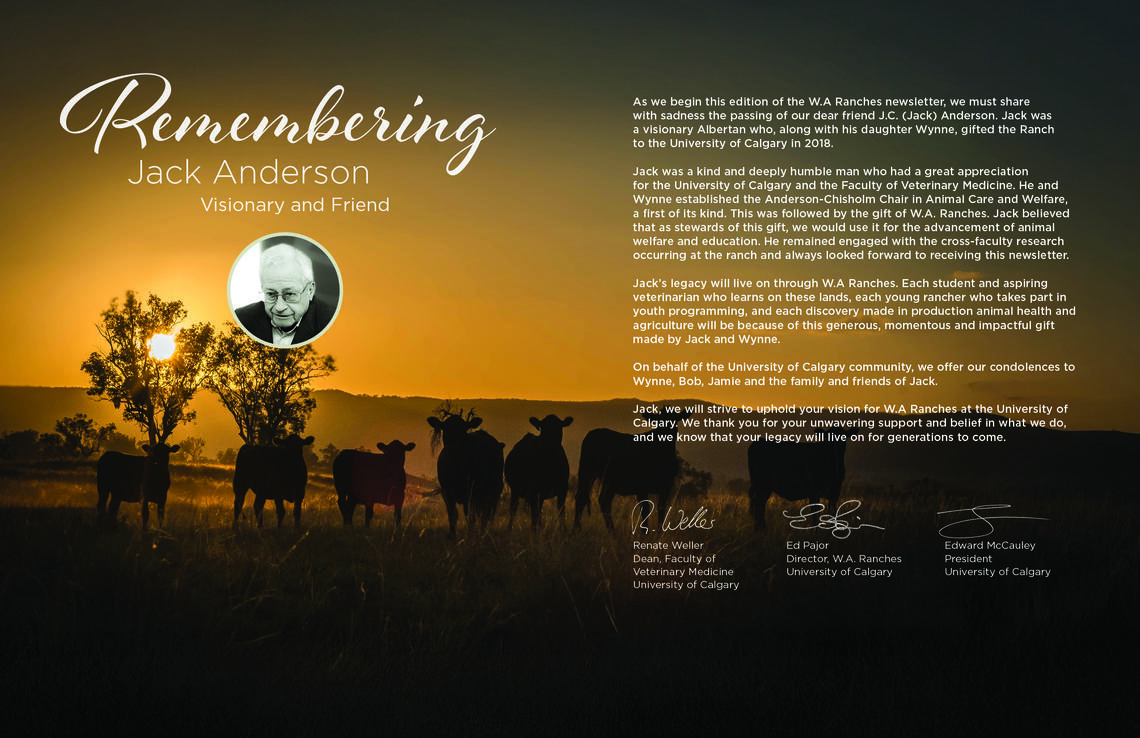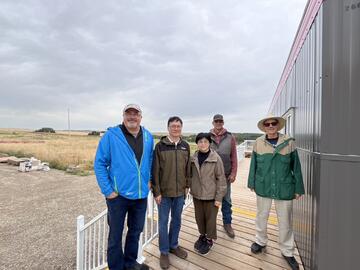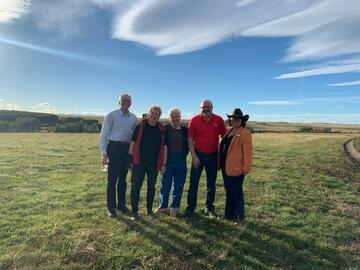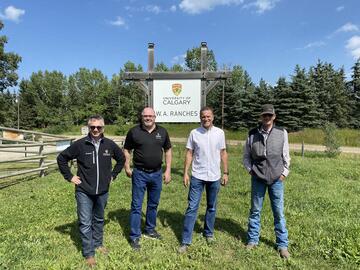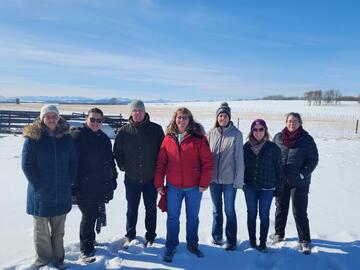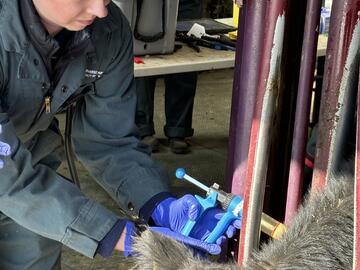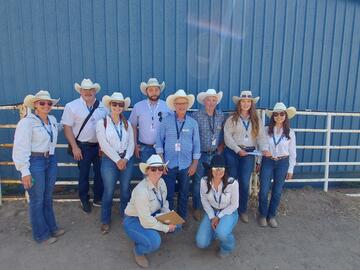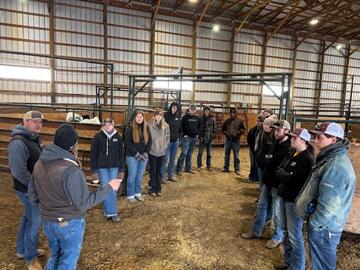Spring 2025 Newsletter
Welcome to the Spring 2025 issue of the W.A. Ranches newsletter. We’re excited to share what’s been happening at the Ranch this past year, and the great things we’ve been able to achieve with the gift of this incredible resource from the Anderson-Chisholm family to the University of Calgary.
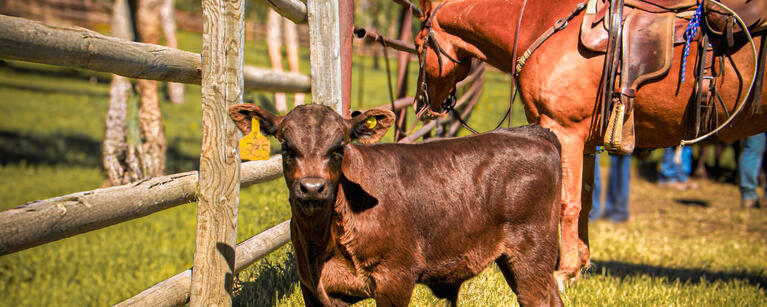
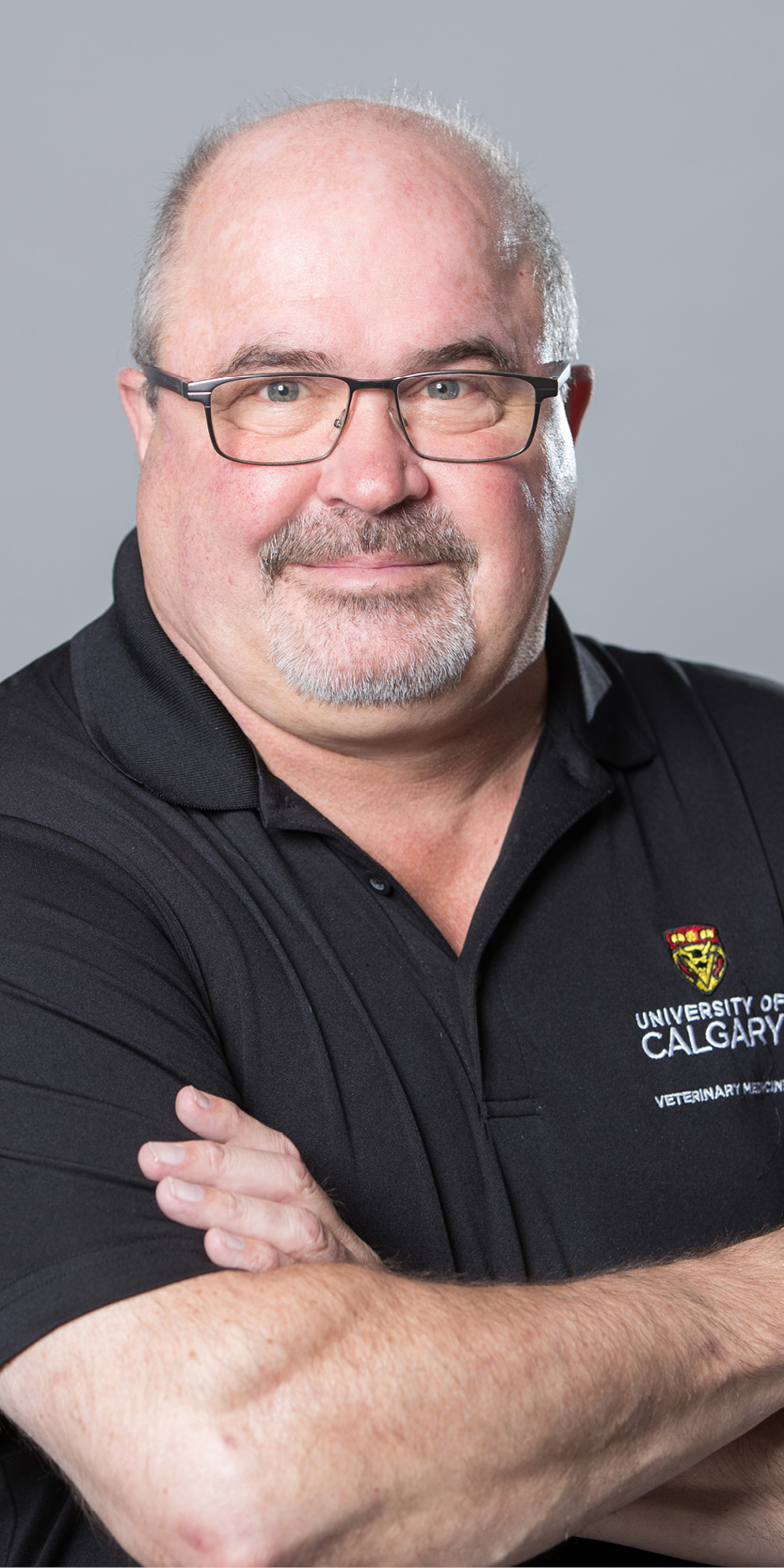
Message from the Director
Welcome to Spring 2025 and a new W.A. Ranches at the University of Calgary Newsletter.
As always, it’s been a busy year at the ranch. Operationally, we’re performing very well and increasingly using data to guide management decisions—a direction I believe is the future of cowcalf ranching. I’m proud of our UCVM graduate students who have successfully defended their theses and published
research conducted at W.A. Ranches. Congratulations to our new PhDs, Drs. Farghal and Mijar. Dr. Mijar’s work was highlighted last year, and you’ll find a
summary of Dr. Farghal’s research in this edition.
As some projects wrap up, many continue—and new ones are launching this year. Many focus on cow-calf management, but others are broader. For example, the agrivoltaics project, first mentioned last year, is expected to begin construction in June. We’re also featuring initial research on plant biodiversity.
Another exciting initiative is the development of a Soil Moisture Mesonet—a network that tracks soil moisture and helps predict floods, droughts, and water
availability by assessing watershed conditions. We’re also developing a new Beef Cattle Health Genetics Program aimed at improving cattle health across their life and production cycles. More details will follow in the next issue.
Our temporary teaching portables, highlighted last year, continue to see increased use. This past winter, veterinary undergrads gained hands-on experience at W.A. on topics such as:
- low stress handling
- vaccinations
- pregnancy checking and
- bull semen evaluations
W.A. also remains a hub for youth activities and 4-H clubs, reflecting donors’ hopes of encouraging youth to pursue careers in agriculture. The University of Calgary continues to invest in W.A. Ranches, improving opportunities for teaching, research, community engagement, and cow-calf operations. This past year has seen improvements to the animal handling facility as well as improved water storage at our Cochrane North locations.
The generous gift of W.A. Ranches from the Anderson-Chisholm family continues to create new opportunities for the University of Calgary. It truly is a
ranch of opportunities.
Dr. Ed Pajor, Ph.D.
Director, W.A. Ranches at the
University of Calgary
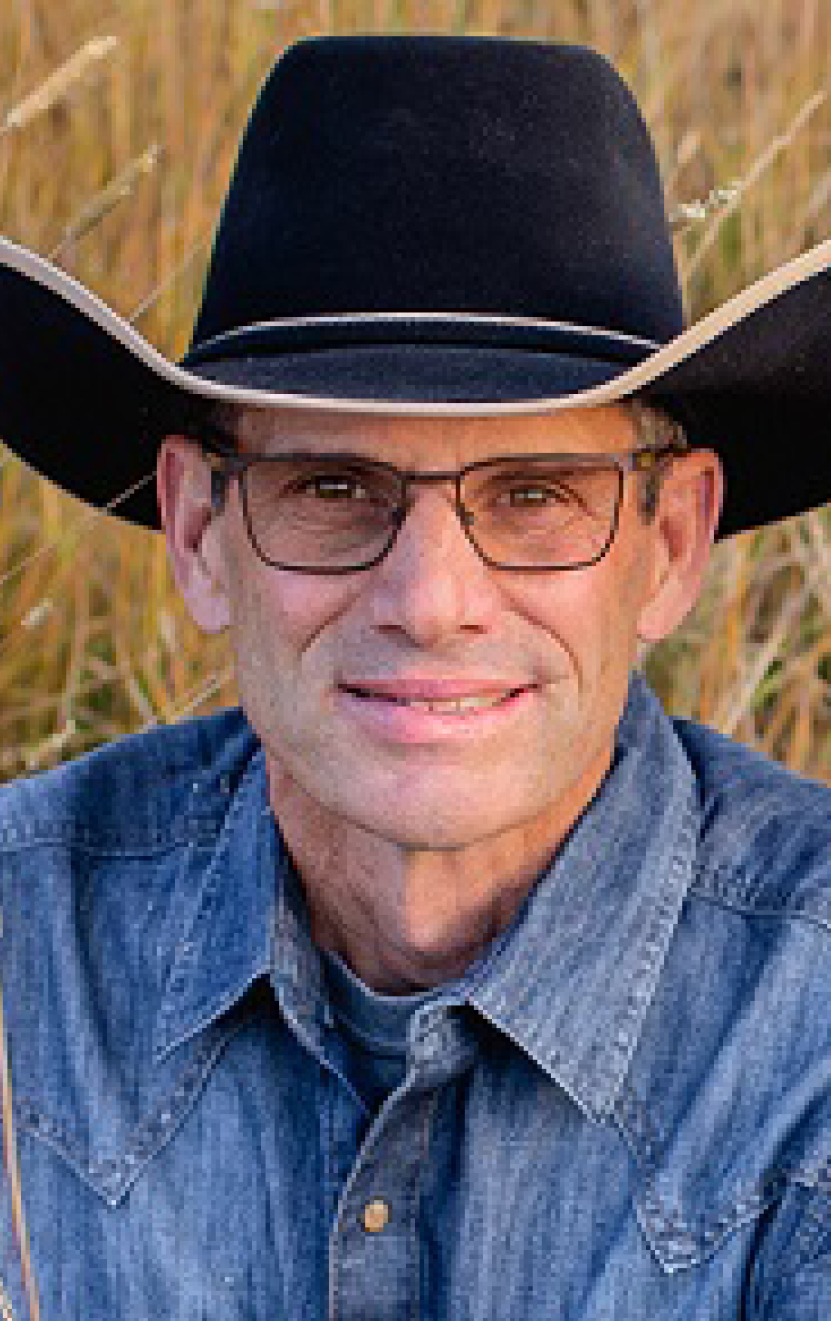
Message from the Manager
2024 was an interesting year, with cattle prices at an all-time high, it’s a lot of fun being in the cattle business right now. The W.A. cow herd once again weaned a high percentage of healthy calves this fall.
A big thanks to the full-time and part-time crew for helping this happen by supporting the animal care program every day of the year. I appreciate all your efforts, and the cattle benefit from your hard work. We selected from our home raised heifer calves, top replacement females to grow into our cow herd, while the remainder of the calf crop made the easy transition from our ranch to a local family-run farm to finish their growth. We follow our calves through to the end, and are seeing carcass data, which is adding to our herd management planning.
We continue to invest in cover crops to reduce our dependency on fertilizer and other inputs, to grow our cattle feed. Despite the below average rainfall we experienced a plentiful hay crop, although we saw a slightly below average yield of silage and swath grazing crops. Thankfully we put up enough good quality feed for our cow herd.
Infrastructure wise, we added another large water storage shed at Cochrane North ranch, upgraded our equipment drive shed at Cochrane Home for heated storage, and completed the installation of a 3-chute livestock handling system for vet student teaching labs at the Cochrane North processing barn.
Jonny Bennett
Ranch Manager, W.A. Ranches at the
University of Calgary
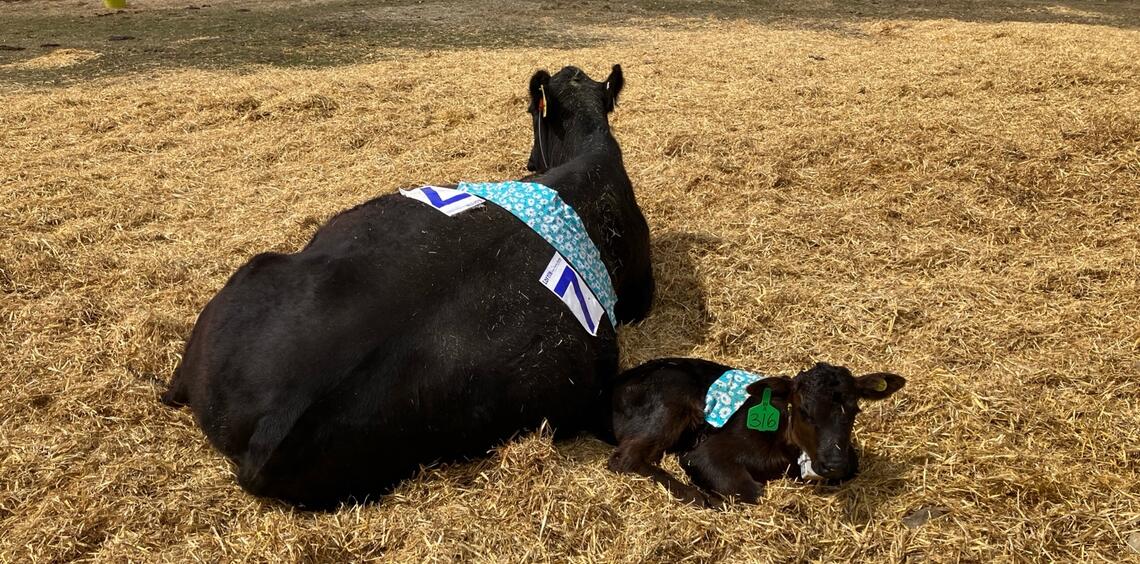
Cow-calf pair identified for observations in spring 2024 using numbered penning tags and matching fabric swatches.
Keeping an Eye on Calves
Developing an Automated Monitoring System for Newborn Beef Cattle
Rachael Coon and Ed Pajor
Under the supervision of Dr. Ed Pajor, Dr. Rachael Coon is exploring how a high-tech collar worn by newborn beef calves could improve health monitoring.
The collar includes GPS tracking, an activity monitor to measure movement, and a proximity sensor that records when a calf is near to the cow. These systems have the potential to aid in the early detection of diseases and injuries, as well as provide researchers with information about the calf’s behaviour and bond with the cow.
In 2024, Coon monitored the behaviour of calves born at W.A. Ranches who were outfitted with these collars during the first two weeks of life. In collaboration with Dr. Vin Camargo (PhD candidate), she validated the proximity sensor’s ability to detect when the cow and calf were within 2 metres of one another.
Coon and Camargo are also correlating the behavioural data she collected, including lying, standing, walking, and nursing, with the activity monitor’s measurements. This is necessary for developing an algorithm to determine what the calf is doing while wearing the collar.
Coon presented this research at the University of Calgary’s 2025 Postdoc Research Slam, where she won first place in the three-minute thesis competition. She will also present her work at the 7th International Symposium on Beef Cattle Welfare at the University of Nebraska-Lincoln in June 2025.
Research will continue at W.A. Ranches in spring 2025, as Coon oversees the transition of data collection from an experimental pen to a larger pasture that more accurately reflects calving conditions on commercial operations.
A big thank you to Results Driven Agricultural Research (RDAR) for their financial support in purchasing the collars and to the Anderson-Chisholm Chair in Animal Care and Welfare for supporting the project.
Exploring Bull Behavior
Understanding Siring Capacity and Health Issues
Vinicius Camargo, Ed Pajor, and Jennifer Pearson
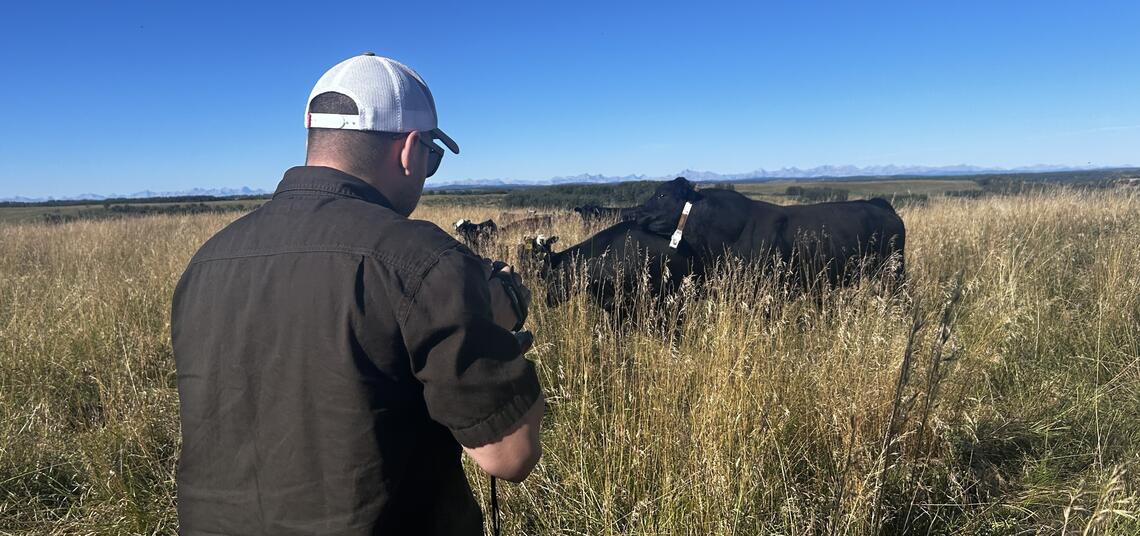
Over the past few years, Vin Camargo (PhD candidate) and his supervisors, Drs. Jennifer Pearson and Ed Pajor, have been using remote monitoring technologies to study bull behaviour and its connection to reproductive success and health. In summer 2024, the group wrapped up their final data collection period at W.A. Ranches.
For the past four years, the team has tracked breeding bulls during pre-breeding and breeding seasons using video, direct observation, and collars equipped with GPS, accelerometers and proximity sensors. As a result, the team developed machine learning algorithms to remotely identify beef bull behaviors, and presented the algorithm’s performance at the World Buiatrics Conference in Mexico last May.
Building on this, the algorithm was then applied to monitor pre-breeding behavior and understand its relationship with bulls’ siring capacity. They observed that more active and social bulls during this period sired significantly more calves, suggesting that these behaviors could be an early indicator of reproductive performance. These findings were shared at the Annual Meeting of the Canadian and American Societies of Animal Science in Calgary last July.
The team also tracked bulls that developed lameness during the breeding season over the past two years. Early analysis shows that lame bulls had a significant drop in activity and walking on the day they became lame, compared to healthy bulls and their usual behaviour. These results highlight this technology’s potential to remotely identify beef bulls’ health issues. These findings will be presented at the American Association of Bovine Practitioners Annual Meeting in September 2025.
As calving season approaches, the team will collect DNA samples from calves sired by the monitored bulls in 2024 to finalize the project and assess how behavior during the breeding season relates to siring capacity. The goal is to identify behavioural changes that could help detect health issues remotely and determine key pre-breeding and breeding traits linked to siring capacity, ultimately improving beef bull management.
Understanding the Impacts:
How Agricultural Practices Influence Wild Rodent Populations and Their Diseases
Laura Budd, Mathieu Pruvot
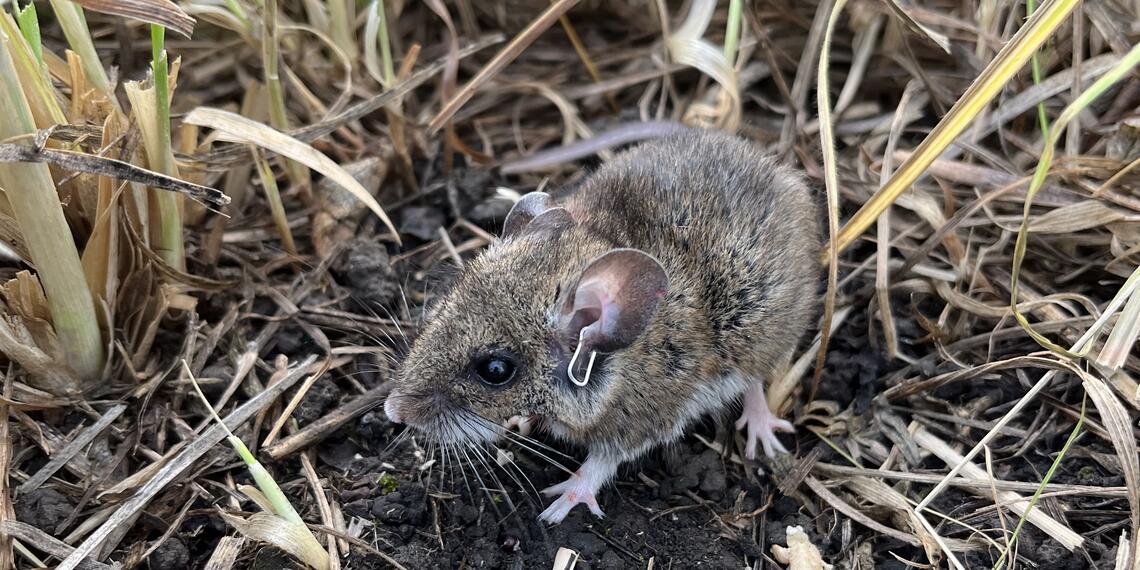
Agricultural settings are important interfaces for disease spillover between wildlife, livestock and people. However, we have limited knowledge of how various farming practices affect disease risk, particularly for rodent-borne diseases. Our research aims to understand how specific agricultural practices in Alberta influence rodent populations and the diseases they carry.
From May to October 2024, we trapped rodents in tame-grass cattle pastures, oat and barley crop fields, and hay fields. During each round, we recorded species, population numbers, movement and collected pathogen samples. We aim to identify which fields different rodent species prefer and how their populations respond to crop growth and activities like harvesting or grazing. We’ll also assess whether rodent movement and space-sharing change in response. Because rodents have short life cycles and adapt quickly to vegetation changes, we expect differences across field types, which may influence disease transmission.
So far, deer mice and meadow voles dominate all three field types. However, deer mice are more common in crop fields, meadow voles in pastures, and both inhabit hay fields. In natural settings, rodent numbers increase from spring to fall during reproductive peaks, but in agricultural fields, deer mice peak when vegetation is tallest and densest, just before harvesting or grazing, causing different peak times across field types. Meadow voles mostly avoid crop fields and continue increasing in pastures through fall, seemingly unaffected by grazing.
On the pathogen side, we are using molecular techniques to assess virus diversity and screen for hantavirus (Sin Nombre). Sin Nombre virus (SNV) is the most common cause of hantavirus pulmonary syndrome (HPS) in North America. So far, it is rare, but infected deer mice appear in crop fields in late summer and fall, which is typical for Alberta. Sin Nombre virus, though rarely infecting humans, can cause severe respiratory illness.
The risk is highest when inhaling aerosolized deer mouse feces, often in enclosed spaces like barns. Increasing ventilation before cleaning and wearing N95 masks is recommended.
We are preparing for a second year of trapping and data collection. Our research aims to determine how different agricultural activities impact rodent-borne disease risk, helping inform sustainable farming practices that also reduce spillover risk.
Calf Grimace Scale:
A Practical Tool for Pain Assessment in Beef Calves
Mostafa Farghal, Maria Camilla Ceballos Betancourt

Before castration
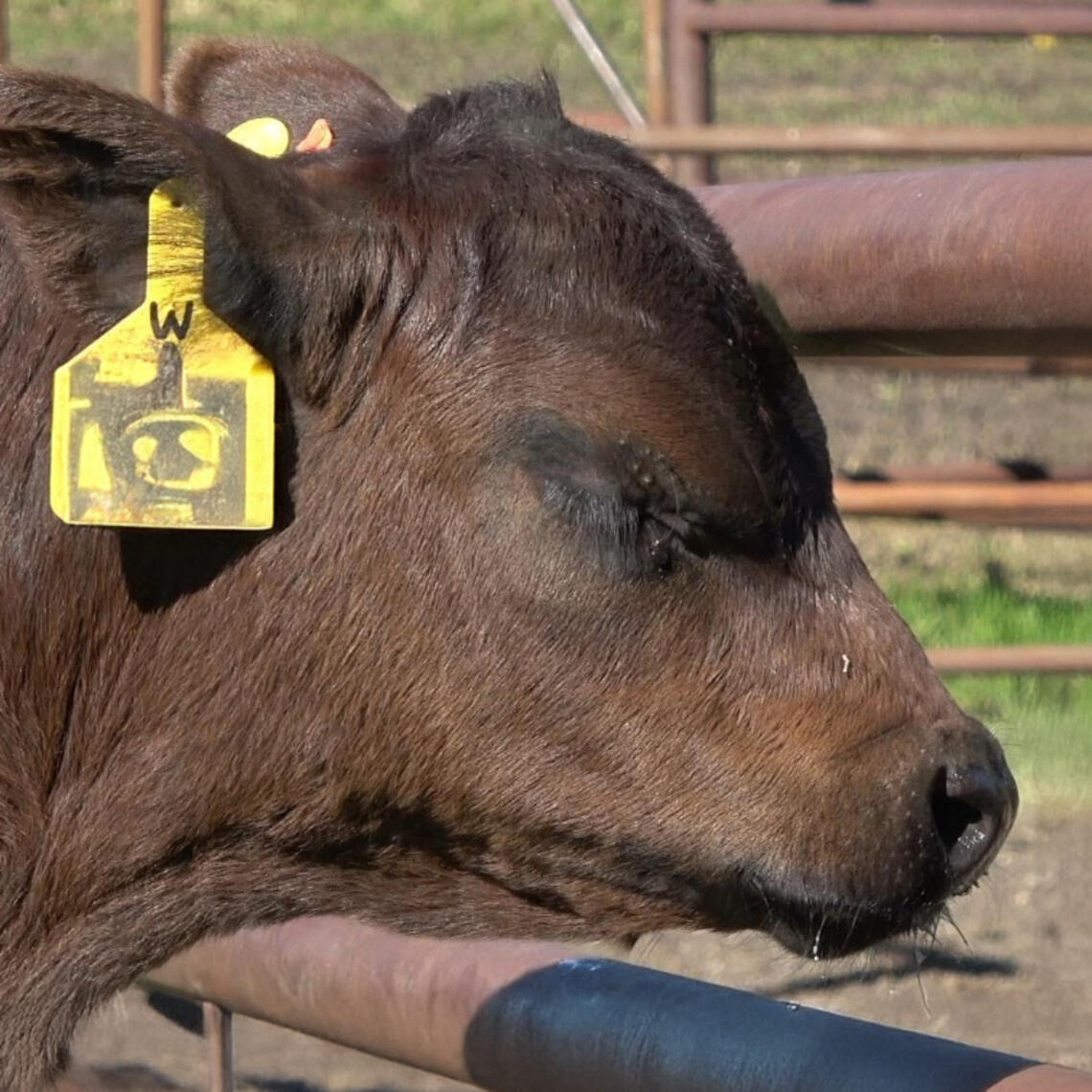
After castration
Assessing pain in cattle is challenging due to their nature as prey animals. Traditional methods, including behavioural and physiological indicators, have limitations. To address this, we developed the Calf Grimace Scale (CGS) as a quick and practical tool for pain assessment in Angus beef calves. Our study involved two groups of calves: one underwent surgical castration, while the other was subjected to a sham procedure. Videos were recorded before, during, and after castration, and front and side facial images were extracted for analysis. ix facial action units were identified to compose the CGS: ear position, orbital tightening, tension above the eye, nostril dilation, straining of the chewing muscle (side view only), and mouth opening.
The CGS effectively detected changes in facial expressions due to pain and stress (e.g., environmental changes and dam separation). After a validation analysis following the COSMIN (Consensus bases standards for the health measurement instruments) guidelines, the CGS had robust validity, excellent intra- and inter-observer agreement, and moderate correlation with pain-related behaviours. The side-view of the CGS performed best under unrestrained conditions, achieving over 80% specificity, sensitivity, and accuracy. A threshold score of 0.5/1 was identified to distinguish between painful and non-painful conditions. While some limitations exist, such as low internal consistency, it remains a valuable tool for pain assessment in beef calves.
Agrivoltaics Research Park:
Establishing biodiversity baselines before installation
Paul Galpern

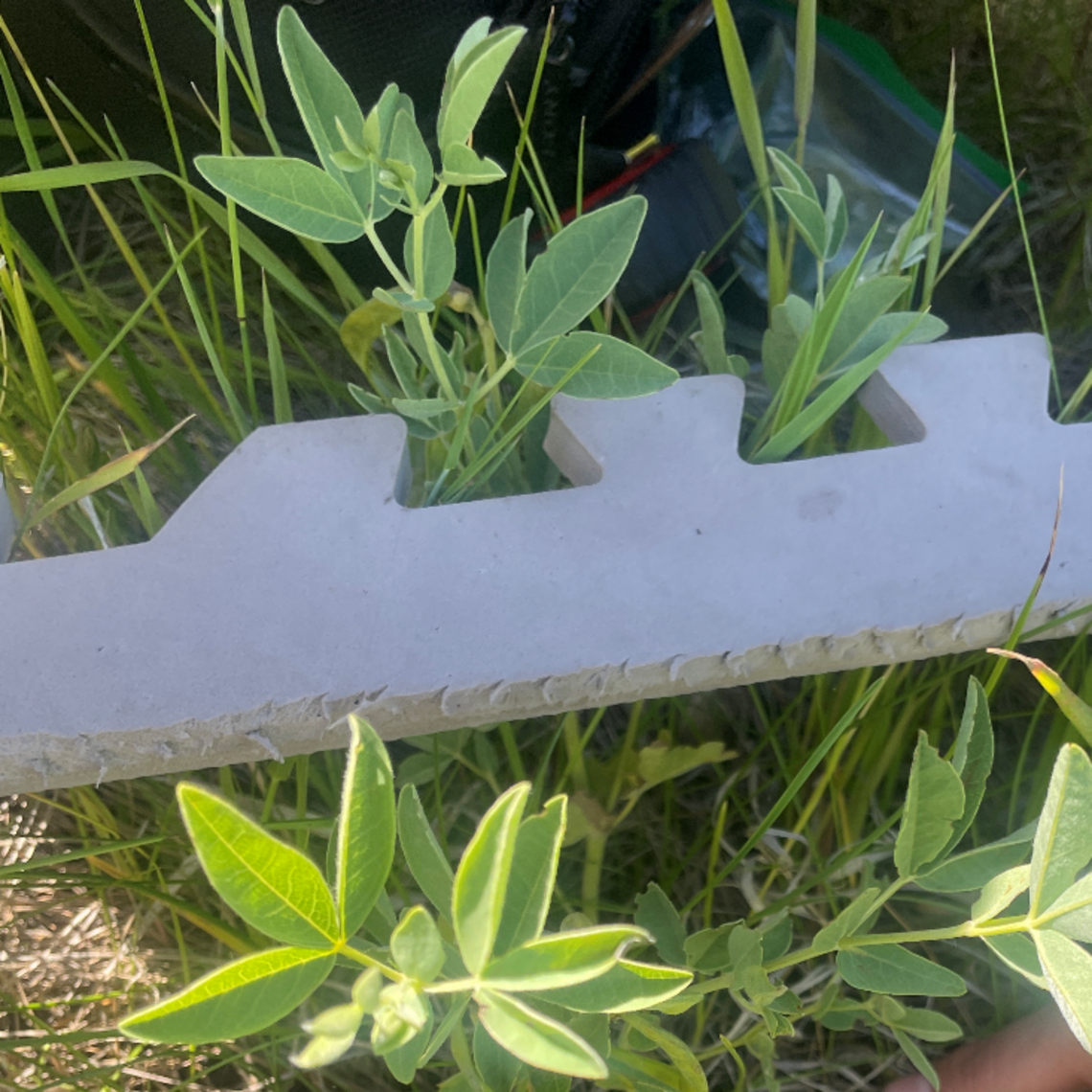
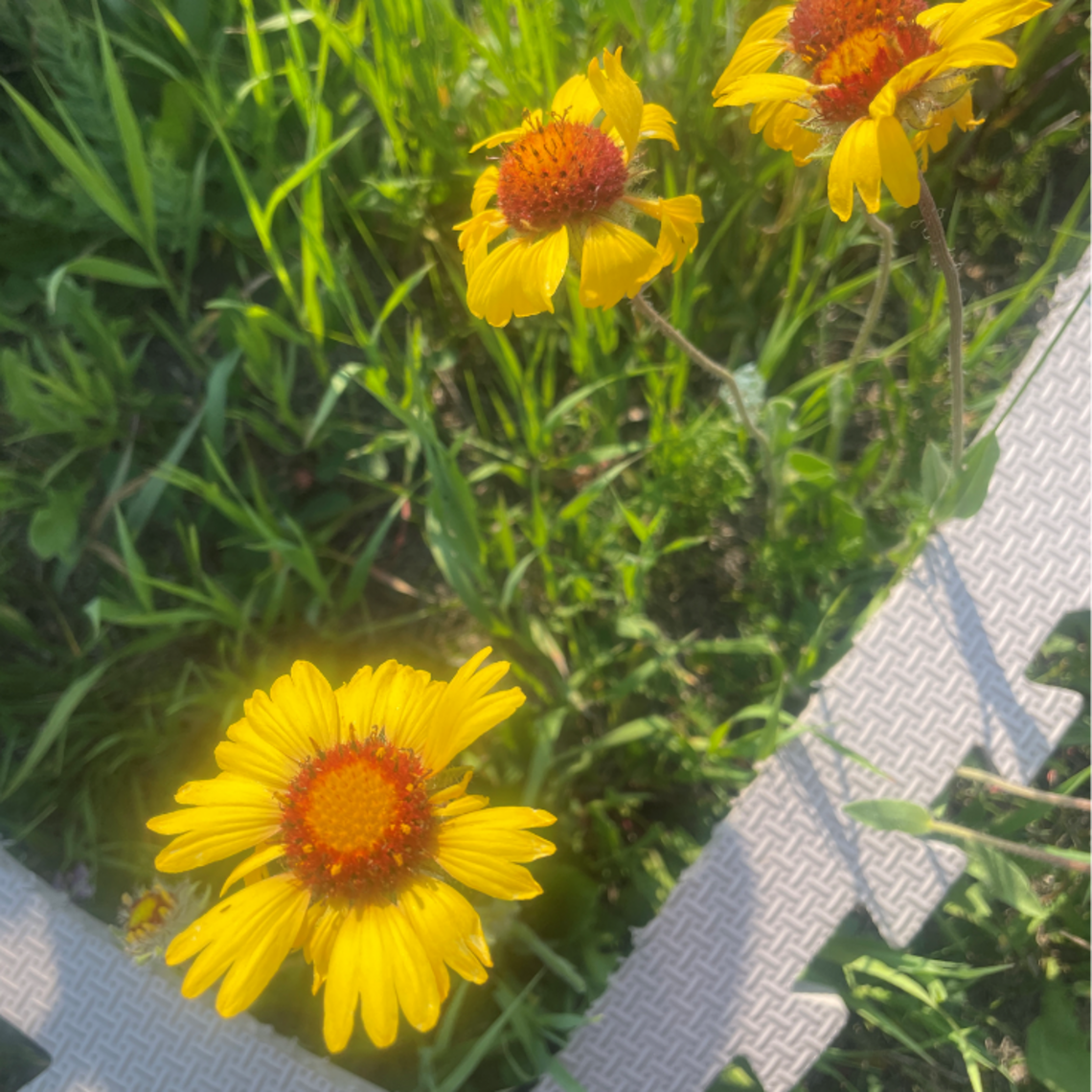
Mismothering, a major concern for beef producers, occurs when a cow fails to bond with her calf. A survey revealed 56% of western Canadian farms experience it, leading to dam culling (61.5%). Mismothering manifests as aggressive rejection (causing injury/death), lack of care, or adoption of the wrong calf. This harms calf survival by reducing immunity transfer, nutrition, and predator protection. Additionally, culling mismothering cows and resolving the issue incur high economic costs.
Despite its prevalence, mismothering remains poorly understood. Current interventions (isolation, restraint, oxytocin) lack scientific backing. Potential causes lie in cow and calf factors, external elements (other cattle, humans, weather) and calving environment characteristics. Furthermore, different “styles” of mismothering, likely due to various factors, haven’t been described.
This study addresses these gaps by defining different mismothering styles and identifying risk factors. Data from 56 mismothering pairs (2023 calving season, 2 ranches) was collected. Isolated and video-recorded, these pairs were observed until bonding or calf fostering. Cow, calf, and environment details were noted, including breed, parity, body condition, udder/teat scores, calving ease, calf sex/weight, twinning status, calving temperature/weather, and pasture density.
Preliminary results revealed diverse behaviors:
- Avoidance (70%): Cows avoid their calf, potentially leading to abandonment or neglect (no licking after birth).
- Nursing rejection (20%): Cows reject nursing attempts (kicking, head-butting).
- Undue aggression (9%): Cows display unprovoked aggression towards their calf.
Evaluating the Impact of Calving Pastures with Varying Isolation Area Density
Effects of Low vs. High Windbreak Density on Cow-Calf Bonding and Mismothering
Emma Roux, Ed Pajor
In the hours before calving, free-ranging beef cows seek isolation, preferably at sites with visual cover. This behavior helps reduce disturbances from humans, predators, or other cattle, strengthening cow-calf bonding. Strong bonding is crucial to prevent mismothering, which can negatively impact cattle welfare and increase labor costs. In Western Canada, pregnant dams often calve in group settings outdoors, limiting their ability to isolate and increasing the risk of poor bonding and calf-stealing.
Providing isolation structures has been shown to enhance bonding and reduce herd interactions in dairy cattle, but its impact on beef herds is less understood. This study aims to:
- Assess how beef cattle use isolation areas (windbreaks) 24 hours before and after calving.
- Compare cow-calf bonding within 24 hours and one to three months post-calving in pastures with low vs. high windbreak densities.
- Compare cow-calf distances within and across pairs from one to five days post-calving in different windbreak densities.
Cows will be distributed across four equal-sized pastures (30 cows per pasture). Two “control” pastures will have four windbreaks, while two “treatment” pastures will have eight.
Wildlife cameras will monitor windbreak use and activity (e.g., calving, bonding). A drone will capture aerial images three times daily to track cattle distribution and measure cow-calf distance over five days post-calving.
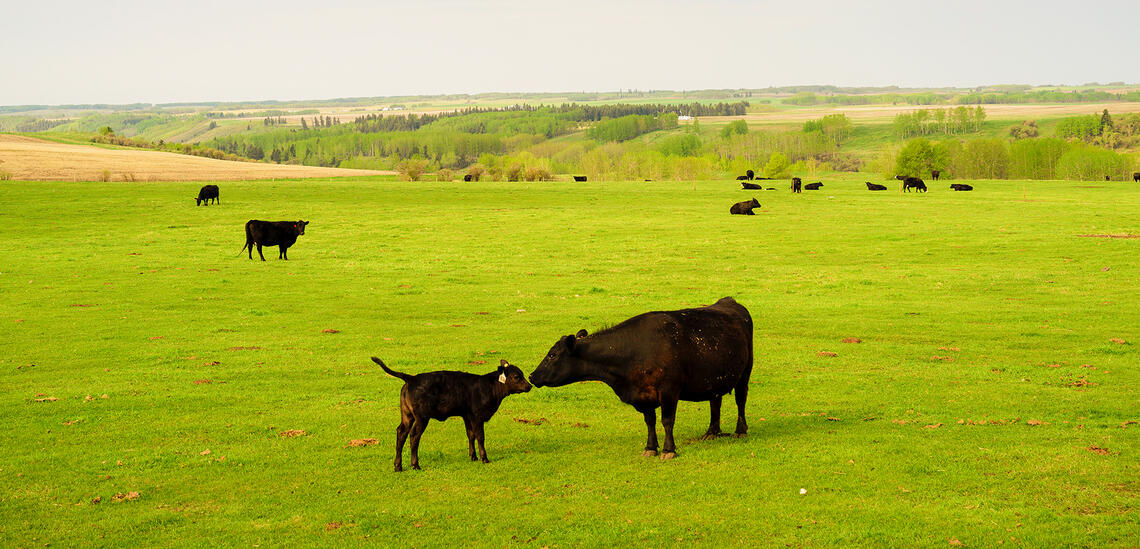
Bonding strength will be assessed by scoring dams’ protective behaviours during newborn-processing.
This project will determine if windbreaks improve bonding, potentially increasing calf growth and reducing illness and mortality. Understanding how cattle use isolation areas will help develop better calving pasture management strategies to enhance animal welfare and productivity in beef operations.
Thanks to the Anderson-Chisholm Chair in Animal Care and Welfare for supporting this project.
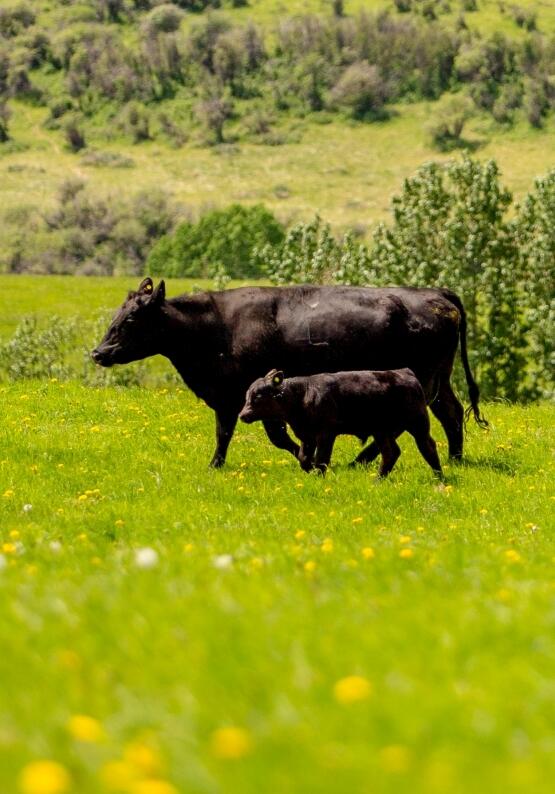
Investigating Hidden Costs of Weaning Management
Christy Goldhawk, Ed Pajor, Karin Orsel
When the pairs come home in the fall, the focus can be on weaning weights and pregnancy check. But have you ever stopped to consider if the methods we use for weaning can affect the developing fetus in those pregnant heifers and cows? Extensive research in multiple species has shown that maternal stress during pregnancy can affect growth, immune function, reproduction, and neurodevelopment (e.g., memory, learning, coping with stressors) of the offspring.
This study builds off previous research conducted at W.A. Ranches in 2022 that identified a potential difference in calf survivability and cognition when their dams had experienced abrupt vs. fence-line weaning while pregnant. In the current study, led by Drs. Goldhawk, Pajor, and Orsel, cows were weaned in the fall of 2024 using either abrupt or fence-line methods and followed through to the evaluation of their calves born in the spring of 2025.
Using refined methods, researchers will evaluate the survivability, health, growth, and cognitive development of the calves born in 2025. The intention is to evaluate if there are hidden costs of weaning management that are retained by the cow-calf operations in their next calf crop.
Buzz off!
The Challenge of Keeping Pest Flies Off Cattle Moo-tivates Vet Med Researcher
At W.A. Ranches, Killam postdoc Rachael Coon tests new ideas to keep herds healthy and happy
When a fly buzzes around your head, deftly dodging your swats, it’s all you can think about.
Dr. Rachael Coon, PhD, thinks about flies a lot too, but in a far more productive way. As a Killam Postdoctoral Fellow in the Faculty of Veterinary Medicine, she’s researching ways to combat pest flies that plague cattle.
Flies cause cattle to stomp, flick their tails, and twitch. They also spread disease, reduce production, and can even contribute to fatalities. For example, pinkeye, spread by flies, costs the U.S. cattle industry an estimated $150 million annually.
While humans can swat flies away, cattle aren’t so lucky. Coon is tackling the problem in two ways: on the cattle and in the fields where flies breed.
Getting Flies Off Cows—and On Camera
At W.A. Ranches, Coon is testing oilers, which function like a “car wash for cows.” These devices let cattle rub against fabric tassels soaked in insecticide-infused mineral oil, keeping flies at bay. Outfitted with brushes and scratchers, the oilers encourage natural grooming behavior while applying treatment.
For prevention, Coon is monitoring pest fly populations. She’s adapted a fruit-fly tracking device for cattle, using a 3D-printed surface with sticky paper and a camera that takes photos every twenty seconds. Called a “Sticky Pi,” it identifies fly species using machine-learning algorithms, allowing producers to track surges and adjust pest control measures.
Sustainable Pest Management
Supported by the Beef Cattle Research Council of Canada, Coon’s approach integrates prevention and treatment. By helping producers monitor fly populations, she aims to optimize pesticide use, reducing resistance and environmental impact.
A Return to Canada
After earning her PhD at UC Davis, Coon returned to Canada for the opportunity to research at W.A. Ranches under Dr. Ed Pajor. “It’s a rare setup for a university,” she says. “Having access to such a large sample size and experienced ranch staff is invaluable.”
Grateful for the opportunity, Coon hopes her work will lead to long-term, sustainable pest management solutions for cattle producers.
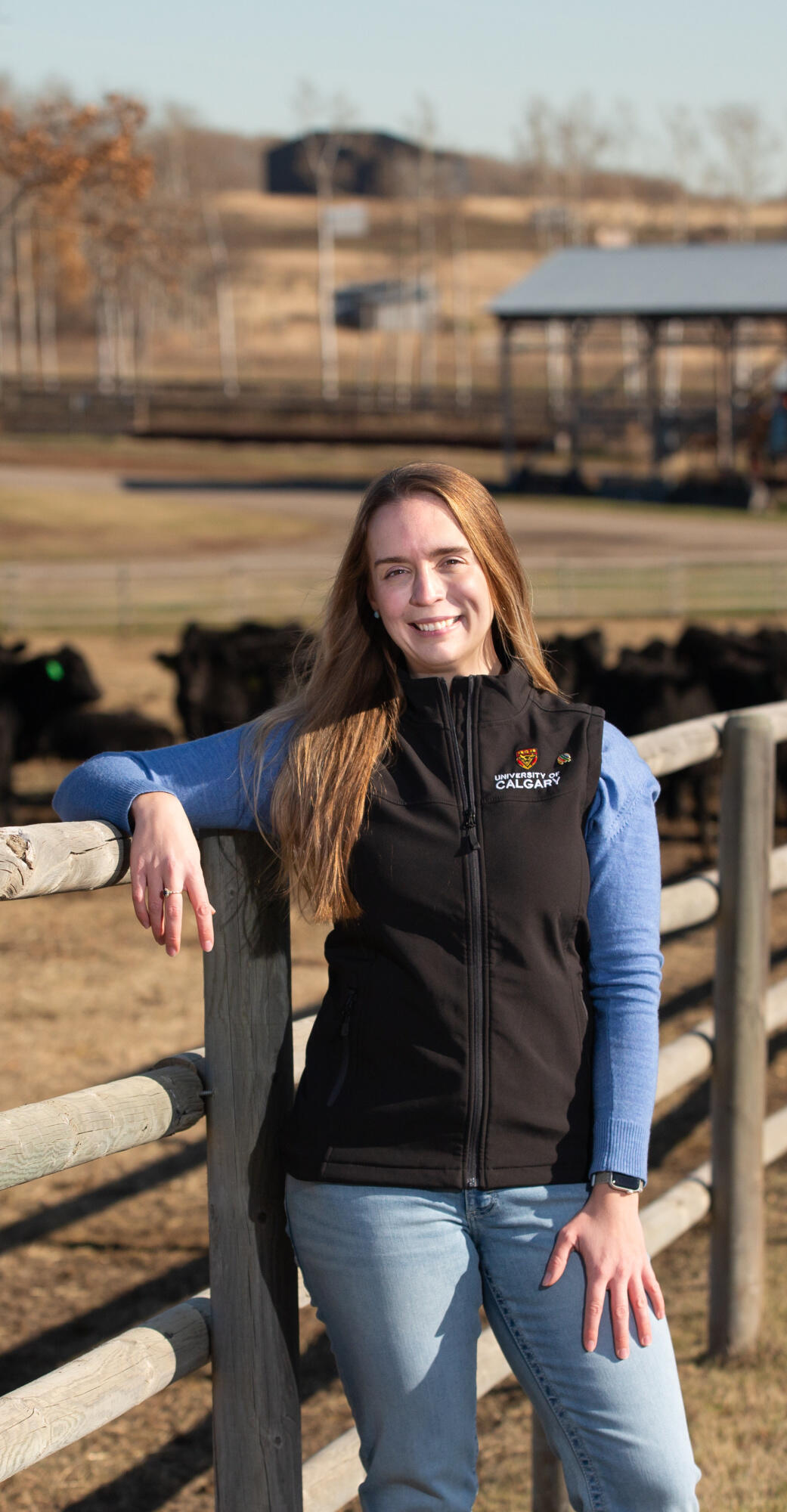
Advancing Soil Moisture Monitoring for Improved Water Forecasting at W.A. Ranches

The Role of Soil Moisture in Hydrological Prediction
Soil moisture is a key factor in hydrological forecasting, affecting streamflow, flood risk, and water availability. It determines whether precipitation is absorbed or becomes runoff, shaping watershed responses. Despite its importance, soil moisture is hard to measure at scale—satellite data offer broad coverage but low resolution, while in-situ sensors are precise but sparse. A combined approach using multiple data sources is essential for accurate forecasting.
To improve prediction capabilities, a new Soil Moisture Mesonet is being developed at WA Ranches near Calgary. It will enhance understanding of watershed conditions and support better forecasting of floods, droughts, and seasonal water availability, aligning with national and global monitoring efforts.
Developing the WA Ranches Soil Moisture Mesonet
The WA Ranches mesonet will include 20 stations measuring soil moisture at 5, 20, and 50 cm depths using Hydra Probes, along with rain gauges and data loggers. Based on a successful 2006 Saskatchewan model, it will capture year-round soil moisture dynamics.
Stations will be located away from active ranch areas to avoid disruptions, enabling efficient and accurate data collection. This dataset will support model validation and improvement by filling gaps between satellite and localized measurements.
Integrating Observations with Advanced Modeling for Water Management
This project supports broader efforts to improve water forecasting by refining initial watershed condition assessments. Soil and snowpack moisture are especially critical in seasonal predictions, particularly in snow-dominated areas.
Data from the WA Ranches mesonet will enhance streamflow modeling through integration with satellite data and data assimilation techniques. The mesonet will serve as a vital research hub for advancing forecasting accuracy, informing water management, and supporting climate resilience in Canada and beyond.
From Researcher to Ranch Hand: Alum Gets in the Thick of It for Giving Day
In Giving Day video series, Dan Allard brings humour to the serious business of supporting UCalgary initiatives
This isn’t Dan Allard’s first rodeo. Dan Allard, BComm’09, grew up in Red Deer, so rural life isn’t new to him. But crawling through a livestock chute for a Giving Day video at UCalgary’s W.A. Ranches? That’s a fresh twist.
As the energetic face of UCalgary’s Giving Day videos, Allard brings humour and heart to his role — dropping to all fours in a mucky barn is just another chance to spotlight impactful university projects that rely on donor support.
“Someone asked if I’d go in the chute, and I said, ‘Absolutely. That’d be hilarious,’” he says. “I love new, ridiculous experiences.”
Playful approach to deliver important message
Each video follows a fun pattern: Allard tries (and fails) to help — sending the message that while you may not be hands-on, you can still support change by donating.
Running until April 18, Giving Day offers donors the chance to double their impact, with eligible gifts matched up to $2,500.
From putting on goalie pads to trying genome editing, Allard has jumped into every scene with full enthusiasm. “I eat that stuff up,” he laughs.
Videos give donors behind-the-scenes look at UCalgary initiatives
Through these videos, Allard has explored UCalgary’s lesser-known corners — like the rooftop greenhouse where Dr. Marcus Samuel, PhD, grows produce for the student food bank, and the SHRed Mobile, a concussion research RV led by Drs. Carolyn Emery and Jonathan Smirl.
At W.A. Ranches, Dr. Ed Pajor, PhD, shared future plans for a new facility that will support research, teaching, and outreach on a larger scale.
“These shoots always leave me saying, ‘Wait, we have that at UCalgary?’” says Allard. “It’s a fun way to show people where their donations go.”
Filming isn’t always glamorous — unscripted takes, lighting tweaks, and messy settings are all part of it. But Allard’s good humour keeps the energy high.
“Some of the things we had him do? That attitude makes it fun,” says Pajor. “He’s a great alum and ambassador.”
Since 2017, Giving Day has raised over $10 million. And thanks to matching gifts, it’s the perfect time to give — supporting everything from student awards to groundbreaking research.
“The university has so much more to offer than people realize,” says Allard. “I just get to help show that off.”
- Adapted from an article first published in UToday (April 12, 2024).
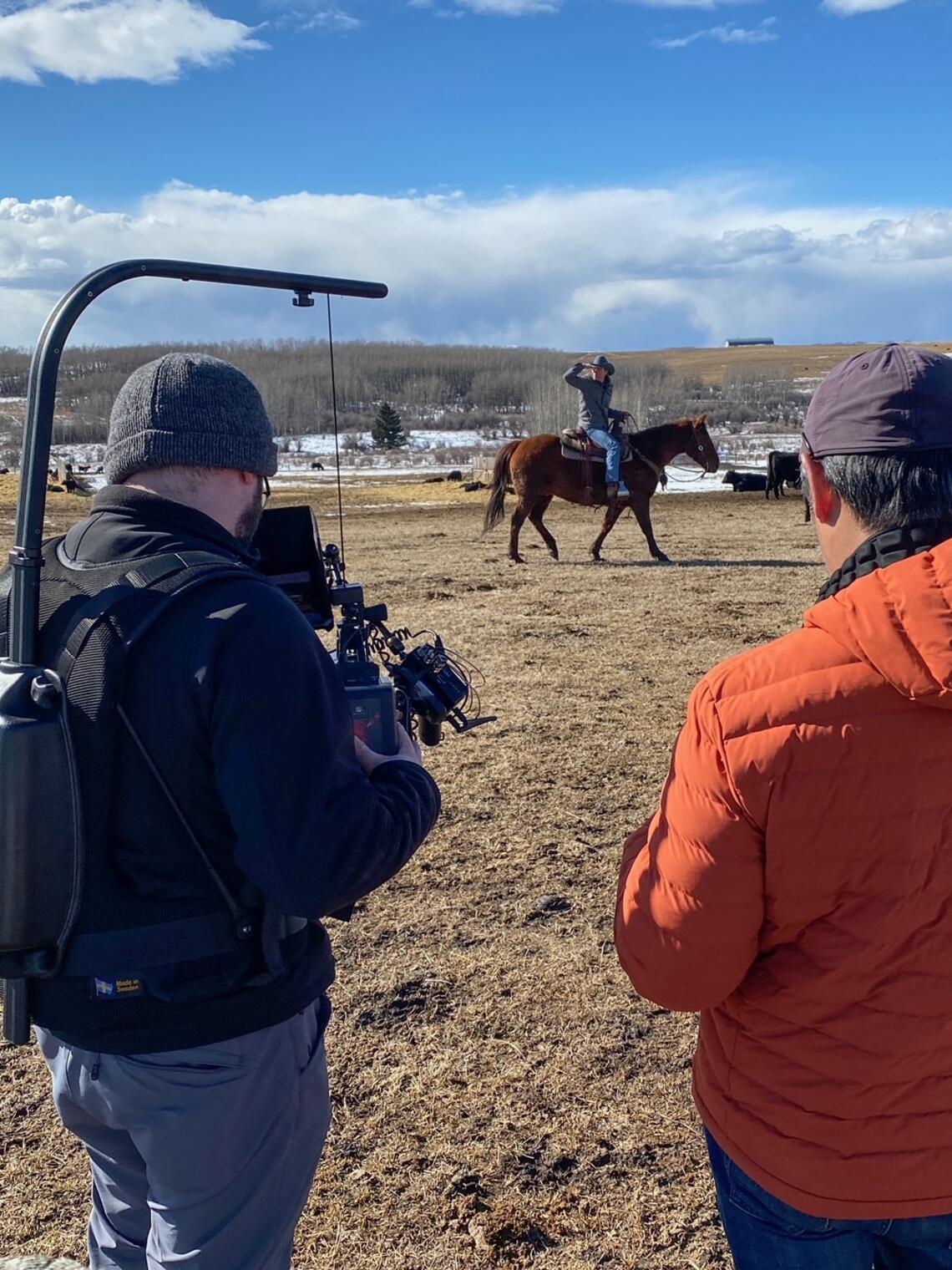
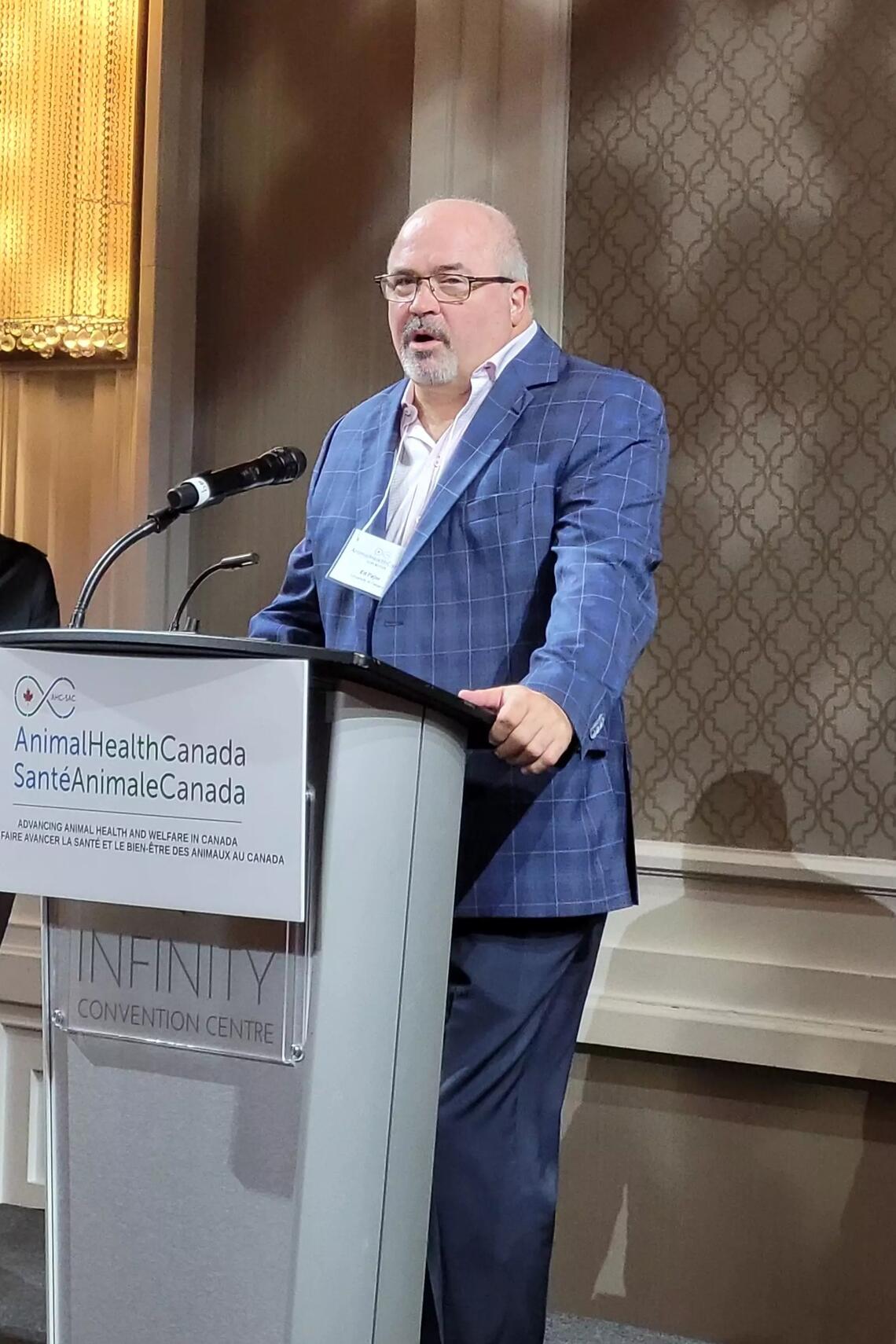
UCVM’s Ed Pajor Honoured with Carl Block Award for Leadership in Animal Welfare
Contributions to animal agriculture and dedication to mentoring the next generation of veterinary professionals recognized
A University of Calgary professor has been recognized for his leadership and dedication to animal agriculture.
Dr. Ed Pajor, PhD, received the Carl Block Award from Animal Health Canada for his contributions to animal welfare and agriculture. With decades of research, industry collaboration, and student mentorship, Pajor’s impact extends across multiple sectors.
“This award means a great deal,” says Pajor. “I’m humbled to be recognized, but none of this is the work of just one person. It’s always a team effort.”
Advancing animal welfare standards
A key achievement in Pajor’s career is his role in developing Canada’s codes of practice for animal care, which set ethical standards and influence food safety, industry competitiveness, and global trade. He has also held leadership roles with producer groups, retailers, and processors, including the National Pork Council (USA), McDonald’s, A&W, and JBS.
Despite his many accomplishments, Pajor finds the greatest fulfillment in teaching and mentorship. “Watching students develop their own ideas and carry forward concerns about animal welfare is incredibly rewarding,” he says.
Innovative research for a changing industry
Pajor’s research tackles major welfare challenges, from pain management to early disease detection in livestock. He is pioneering the use of AI and data loggers to monitor animal behavior and health, providing real-time insights that could revolutionize livestock care.
“We’re using technology to identify disease earlier, which helps reduce suffering and improve productivity,” he explains.
As academic and research director for W.A. Ranches, Pajor was instrumental in securing its donation—19,000 acres dedicated to hands-on education in animal care.
Shaping the future of animal agriculture
Pajor hopes his work has improved farm animal welfare and inspired the next generation of researchers and veterinarians. Looking ahead, he sees precision technologies as a crucial tool for addressing industry challenges while ensuring ethical treatment.
With a lasting legacy and ongoing research that continues to push boundaries, Pajor remains committed to shaping a more sustainable and humane future for animal agriculture.
Rachael Coon wins UCalgary’s Postdoc Research Slam
Contributions to animal agriculture and dedication to mentoring the next generation of veterinary professionals recognized
Dr. Rachael Coon, PhD, from the Faculty of Veterinary Medicine, took first place at the University of Calgary’s seventh annual Postdoc Research Slam. Her presentation, “Keeping an Eye on Calves: Developing an Automated Monitoring System for Newborn Beef Cattle,” captivated the judges, highlighting her innovative approach to improving cattle health.
The competition challenges postdocs to present their research in just three minutes. Coon’s engaging storytelling and innovative approach to cattle health set her apart.
“Being a postdoc is challenging, but this event builds community and improves communication skills,” she said. “My advice? Connect with your audience emotionally or with humor.”
Her research aims to enhance cattle welfare through automated monitoring. The Research Slam continues to spotlight groundbreaking work while helping postdocs refine their public speaking and network across disciplines.
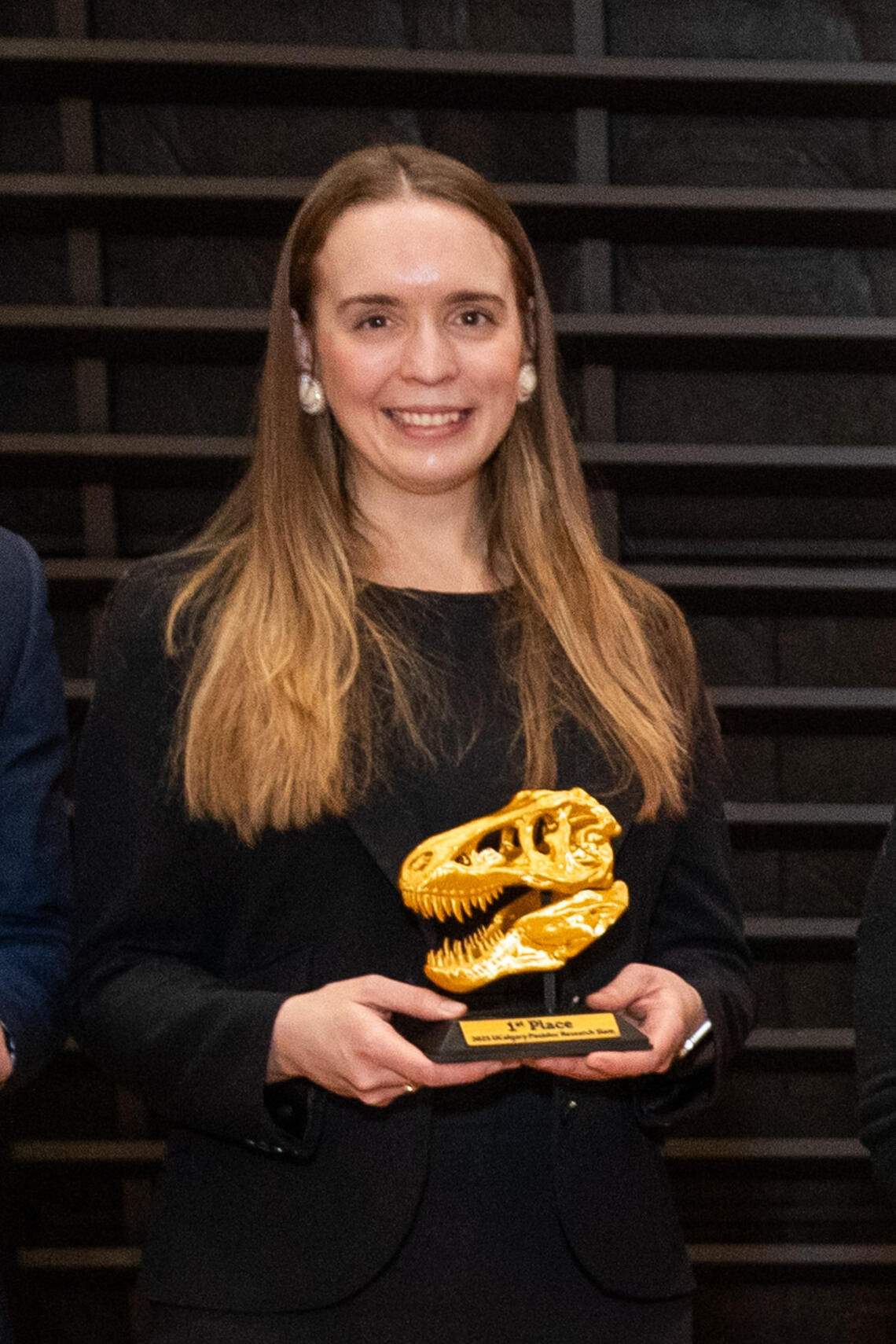
Congratulations to recent graduates that involved W.A. Ranches in their graduate work

Scientific Publications from W.A. in 2024!
Our researchers continue to push the boundaries of innovation in animal science, tackling everything from precision monitoring to public perceptions of welfare. Here are some of the latest findings:
🔍 AI-powered tracking is revolutionizing how we monitor beef bulls. A new study shows how accelerometer data can predict key behaviors. (Camargo et al., 2024)
🐂 Activity and social interactions in bulls impact breeding success. Understanding pre-breeding behavior could improve reproductive efficiency. (Camargo et al., 2024)
😟 A “Calf Grimace Scale” helps assess pain and stress in castrated calves. A breakthrough in humane cattle handling. (Farghal et al., 2024)
👀 Public opinion matters. Surveys reveal how Canadians view calf handling practices. (Goldhawk et al., 2024)
📉 Weaning stress affects calf resilience. Early-life stressors could have long-term impacts. (Goldhawk et al., 2024)
💰 Assisted calving: is it worth the cost? New research breaks down the economic impact for cow-calf operations. (Lucio et al., 2024)
💊 Pain management in assisted calving improves outcomes. Nonsteroidal anti-inflammatory drugs could make a difference. (Lucio et al., 2024)
🔬 Understanding feedlot stress in steers. Behavior patterns—not cortisol levels—indicate transition-related stress. (Mijar et al., 2024)
UCalgary’s W.A. Ranches Youth Outreach:
Fostering Young Minds Towards Bovine Care
It’s calving season, and the call you’ve been expecting comes in at 4:00 a.m. A cow-calf producer’s heifer needs your help getting the calf out. You climb out of your cozy bed, put on your coveralls, and hop into the truck. It’s a forty-minute drive to this property, down swaying back roads, snow coating your windshield. It’s a cold spring, snow still on the ground, and you ask yourself why you signed up for this. But you know this pair needs you.
After forty-five minutes of bear wrestling (oops, I mean delivering a calf), the calf is out. Dam and calf bond and then the calf instinctively begins to suckle. They’re going to be okay. You think to yourself, “That’s why I signed up for this.”
As you reflect warmly on your morning’s work, you have the nagging fear in the back of your mind that the next generation isn’t as keen to sign up for this. With a known shortage of veterinarians throughout Canada, the challenge is amplified in rural areas, and even further in large animal practice. I guess everyone likes sleeping in.
Well, the University of Calgary Faculty of Veterinary Medicine (UCVM) is here to wake people up! And we know that we need to start with youth and foster within them a love of animals and nature during their formative years. To do so, UCVM, along with UCalgary’s W.A. Ranches, offers a host of practical workshops and courses for youth to dive in and get their hands dirty.
The foundation of the workshops is the online Beef Cattle Health & Welfare Youth Certificate Program. Designed as a preparatory program, this eight module course equips participants with fundamental knowledge about bovine health and welfare best practices which they can then use in the next workshops and apply the knowledge, hands-on, that they’ve learned online.
Throughout the school year, W.A. Ranches hosts three separate, in person, bovine specific workshops. These programs are made possible by UCVM faculty and graduate students, volunteering their time to ensure that skills and best practices are the focus.
The first workshop, on handling, is in late fall, post-weaning. In this seminar youth learn stress-free cattle handling practices including identifying an animal’s flight zone, balance points, potential distractions, and above all, a strong focus on safety for themselves and the animals. They experience cattle behaviour and safe pen handling, and proper use of handling facilities, such as a crowd tub, which is conducive to cattle’s natural movements. Students also experience how their own behaviour and energy impact how the animals work.
The second workshop is early in the new year, to teach about calving and calf health. It takes place at UCVM’s Spy Hill Campus where teens get to experience the difference between normal versus abnormal calving scenarios and possible outcomes. The highlights of this workshop are often the calving simulators.
Students have shared that the simulators and tools help them understand what to do, how to do it, and get a true feel for different calving scenarios in a stress-free environment.
The third workshop focuses on bovine lameness, anatomy, and injections. Youth in this workshop learn how to identify and score lameness, examine limb anatomy, critically decide what is normal and abnormal, and learn vaccine and injection best practices in a safe and effective manner.
Lastly, for those looking to dabble in a few areas of veterinary medicine, every summer since 2011, UCVM hosts Vet Camp, in which young people get a “sampler” of all things veterinarian.
For one week, youth are exposed to a multitude of specialties within the veterinary field, including small animal, equine, wildlife, exotics and zoo, and, of course, large animal, with a particular focus on bovine. These popular camps are run solely by our own first-year Doctor of Veterinary Medicine (DVM) students and supervised by a dedicated faculty member, Dr. Robert McCorkell, DVM, Associate Dean of Admissions and Outreach at UCVM.
With UCVM doubling the intake of DVM students from fifty to one hundred starting in fall 2025, and subsequent construction to accommodate the additional students at the Spy Hill campus, Vet Camps will be held virtually for summer 2024, allowing for better access for geographically isolated youth.
As always, youth are blazing the path forward with technology and sustainability. From consultations with various beef industry leaders, there has been an interest in material on topics such as sustainable agriculture, technology in beef production, and career opportunities in the beef industry. Online courses touching on these subjects are currently in development and will be available in the not-too-distant future.
UCVM is immensely grateful to the Canadian Cattle Foundation for their unwavering support of the online courses and in-person workshops. Their dedication to fostering educational programs is both inspiring and instrumental in nurturing the passion for bovine health among young minds. Their ongoing commitment has allowed the creation of unique opportunities for youth to understand and appreciate the significant role of bovine veterinary practice in society and in the economy.
Through the partnership with the Canadian Cattle Foundation, and under the leadership of Dr. Ed Pajor, Ph.D., Director of W.A. Ranches and the Anderson-Chisholm Chair in Animal Care and Welfare, the youth programs at the ranch (and beyond) are made continuously possible.
The University of Calgary’s Faculty of Veterinary Medicine takes great pride in its contribution to the community and the cattle industry. Our youth outreach programs are not just about teaching best practices, they are about sparking something — a passion for animals, a commitment to sustainable agriculture, and an entrepreneurial spirit that drives innovation and progress.
We are not just educating the next generation of veterinarians and industry leaders, but also inspiring them to think differently, to take initiative, and to learn from their experiences. Because at the University of Calgary, we know that every great journey starts with a single step. And for our youth, that step begins here, with us. We look forward to seeing where their paths will lead, and we are confident that with their passion and our support, the future of the bovine industry is in good hands.
- Adapted from an article first published in the WCABP Fall 2024 Newsletter.
Showcasing Youth Skills in Agriculture
Cremona 4-H Club Hosts Annual Multi-Judging Event at W.A. Ranches
The weather could not have been better to host the 27 youth members, 12 parents and 4 guest judges at the Cochrane North facility at W.A. Ranches on March 1st, 2025. The Cremona 4-H Club held its annual multi-judging competition, where members, after given a short criteria talk from the judges, must analyse a set of four samples of a class, place from top to bottom, and be able to sell the reasoning to a judge, with professionalism. This required component of 4-H, teaches youth how to make informed decisions, and practise communication skills.
The warm, sunny, wind-free afternoon, with a mountain view was a welcomed treat, since several classes provided by the ranch, Replacement Beef Heifer and Ranch Horse, had to be judged outdoors. Members would look at the structure, conformation and movement of the animals to decide which animal would be best suited for ranch life. Matt Edwards, an experienced stockmen and former 4-H member himself, took the task of bovine judging. Deb Erickson, owner of Highland stables, accredited equine rider/coach, and a 4-H member from her own youth, deciphered the ranch horse placings and heard the members share their reasons for the ranch horse competition.
Using the roomy classrooms on site, the members rotated through classes of Feed Silage, Horse Hay, Welding Samples, Weed ID and Forage Seed ID. Feed expert Meaghan Edwards, joined in the day, herself being a Cremona 4-H Club Alumni, and enjoyed sharing her knowledge and judging skills. Geoff Rohleder, a weld inspector by trade, the General & Metal Working project leader of Cremona 4-H Club, taught youth the best weld to fuse metal together.
All the volunteer judges chimed the same message of the importance of youth being the future of our Agriculture sector, and 4-H being an important player in building confident individuals, through fun events such as the this one held at W.A. Ranches!
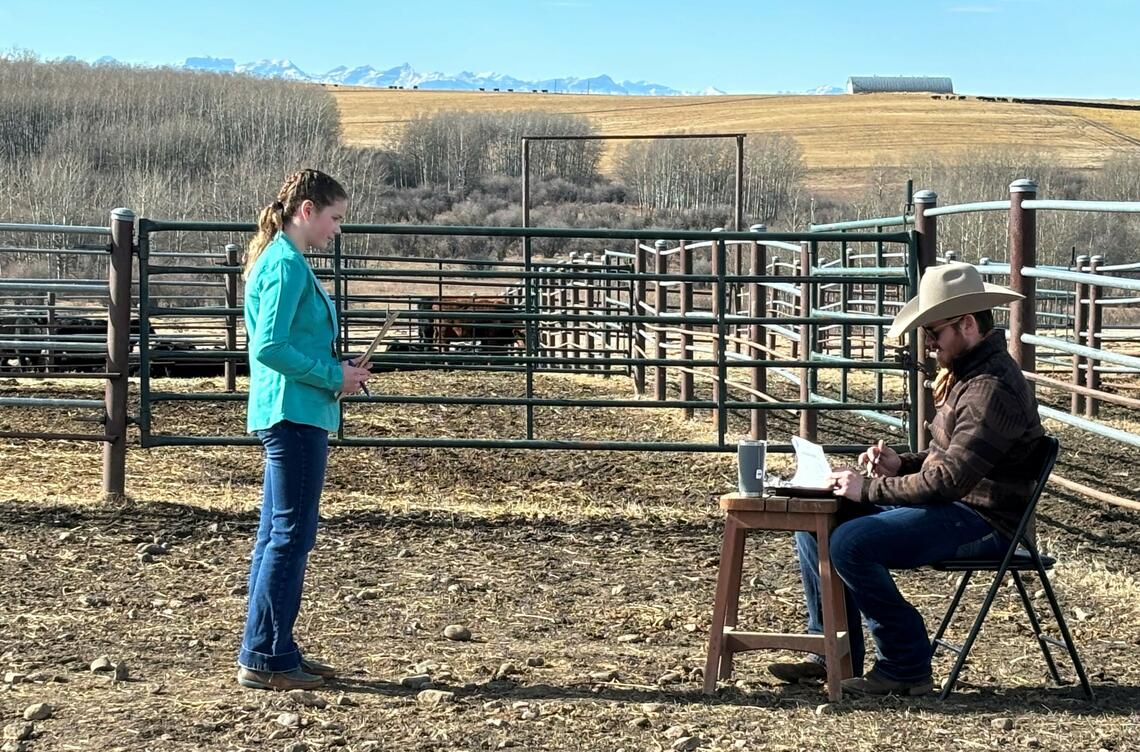
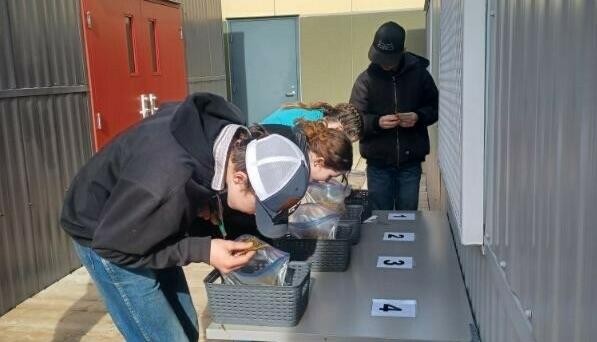
Youth Workshops (Calving & Calf Health)
The online Beef Cattle Health & Welfare Youth Certificate Program continues to prove a valuable education piece as the course saw further registrations and completions. The eight online modules remained highly beneficial for participants, preparing them for onsite, hands-on clinics designed to complement and enhance their online learning experience. One participant stated, “Doing the online modules prior to the clinic was useful and helped me learn more at the clinic”.
In mid January 2024 we hosted our third calving and calf health workshop at the UCVM Spy Hill campus, with 9 youth participants, some traveling despite the weather from as far as Mayerthorpe and Barrhead to join the day’s activities. The smaller workshop allowed everyone the ability to experience different scenarios pertaining to normal and abnormal calving situations.
Sincere thanks again to Dr. Claire Windeyer, Dr. Jennifer Pearson and PhD candidate Dr. Vinicius Camargo for volunteering their time to help run this popular event. One youth participant shared “The activities were interesting and fun” and another stated “The instructors taught in a way that I understood”.
We are again grateful for the support of the Canadian Cattle Foundation, which makes these valuable youth programs possible.
Future youth programming continues with the development of a second online certificate geared towards urban and rural youth. The course focuses on topics such as sustainable agriculture, the future of technology in beef production and explore career opportunities in the vast beef sector.

Church Summer Students: Bridging the Gap
Maggie Anderson’s Path from Urban Roots to Veterinary Medicine
Maggie Anderson completed her Bachelor of Science, majoring in biology with a minor in business, at the University of Calgary in 2024. She applied to UCVM in fall 2024 and previously served as president of the Pre-Veterinary Students’ Association at UCalgary.
Maggie would like to pursue a career in large animal medicine or rural mixed practice. Growing up in the city, she felt she needed more experience working with large animals, which led to developing a keen interest in production animal health.
Maggie spent the past two summers conducting dairy research and recently entered into beef cattle research. The summer of 2024 was slightly different, she was one of two Church Summer Students at W.A. Ranches and also worked as a summer student in Dr. Ed Pajor’s lab. She jumped at the opportunity to work with Dr. Pajor and W.A. Ranches’ cattle, as she felt there is often a high barrier of entry into working with beef cattle for those who did not grow up in rural areas.
She believes it is extremely important to provide opportunities for young people to pursue fields that support rural sustainability and development.
Maggie had an action-packed experience in 2024, starting in May with Dr. Rachael Coon’s calf collar project. This involved evaluating the behaviour of collared calves while transmitters were placed on dams to calibrate the technology. Maggie also worked with Emma Roux on the mismothering project.
By summer, Maggie was helping with calf processing and gained plenty of hands-on experience at the ranch. In July, she was immersed in research at the Calgary Stampede on bucking stock, focusing on welfare assessment tools and heat stress during the 10-day event. She also took part in the fly avoidance behaviour project conducted by Dr. Coon.
Maggie is very grateful for the opportunity to gain experience handling beef cattle at a ranch with such high standards in technology, research, veterinary medicine, ranch staff, husbandry practices and overall management. She hopes to carry this experience into a future career as a veterinarian.
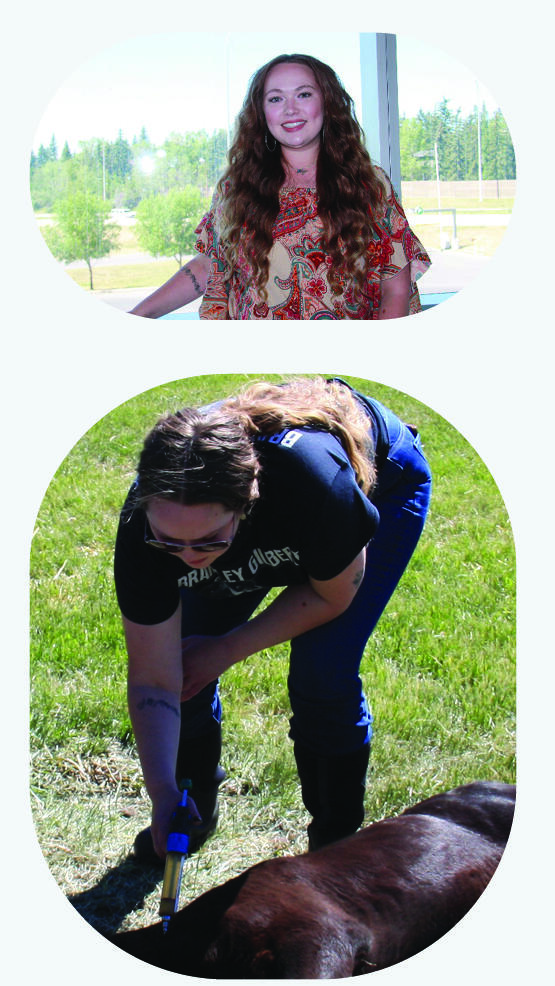
Church Summer Students: From Ranch Life to Research
Dusty Bennett Explores Animal Science at W.A. Ranches
Dusty Bennett is an undergraduate student in her second year at the University of Saskatchewan’s College of Agriculture and Bioresources, pursuing a Bachelor of Science in Agriculture (B.S.A.) in animal science. Her future looks bright as she considers either pursuing vet school or becoming a registered veterinary technologist (RVT) in the future, and yet still considers a career in ranching would make life just as sweet.
Dusty hails from an Alberta ranching background. Both her mother and father met while working at Simpson Ranch near Cochrane and have resided near Water Valley since Dusty was 13 years old. She grew up around plenty of cattle and horses, which prepared her well for the opportunity to start helping at W.A. Ranches at the age of 16, something she has done every summer since.
This past summer was slightly different, as Dusty was one of two Church Summer Students at W.A. in 2024, primarily assisting with bull research alongside Dr. Vinicius Camargo.
“Working with Vin was great. Driving around to check the bulls, talking to him about veterinary medicine and getting to understand more about bull behaviour, breeding, their routines and overall health has been very valuable,” said Dusty. “This experience has shown me a different side of research. It’s interesting, and being behind the scenes has its highs and lows for sure. I enjoy mostly being outside doing the field work, but this has opened my eyes to the computer work and hours of video analysis that also come along with research.”
Dusty added that the W.A. Ranch bulls are great and seeing the research results shows what good health these bulls are truly in, something she presented during her Summer Undergraduate Research Experience (SURE) program presentation related to research, data and analytics.
Dusty also contributed to research at the 2024 Calgary Stampede, recording bull behaviour in their pens, checking to see if data collection devices were accurate and gauging heat stress in alleyways with infrared camera technology.
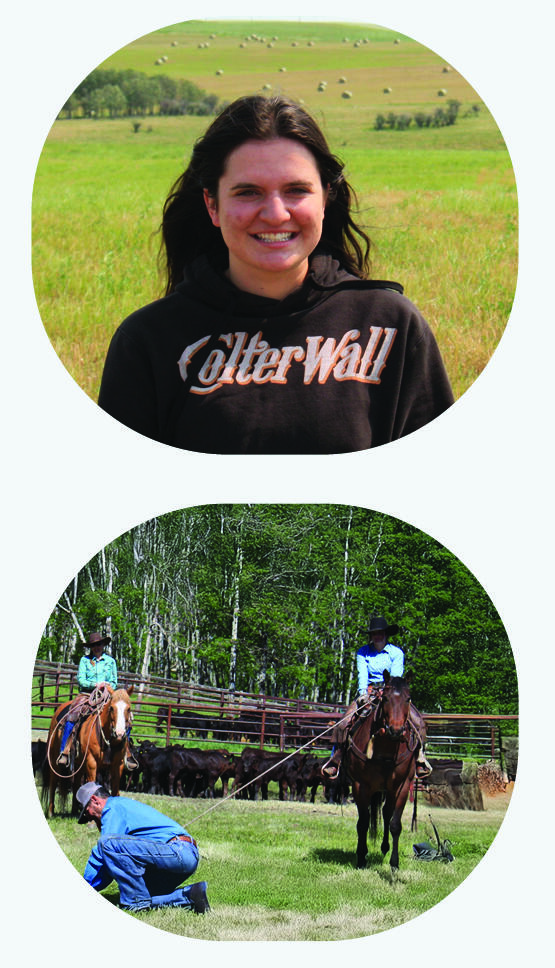
Calving Volunteers at W.A. Ranches

The calving volunteer experience at W.A. Ranches provides first- and second-year veterinary students with the opportunity to immerse themselves in the daily activities of a working cow-calf ranch.
The unique program is led by UCVM’s Dr. Jennifer Pearson, assistant professor in bovine health management.
“This was the fourth year running the program and the number of students interested continues to grow every year. The students assist ranch staff with observing cows for signs of calving, tagging and vaccinating newborn calves, and assist with daily tasks during calving season. These opportunities provide our veterinary students with exposure to the beef industry early in their careers and many now have a new interest in pursuing mixed or large animal practice after the experience,”said Dr. Pearson.
The chance to gain familiarity with calving practices, and exposure to both the miracles and challenges of calf health, proves to be a popular and priceless opportunity unique to W.A. Ranches. Here are some reflections from the 2024 program:
Jacqui Gironella
My W.A. Ranch shift was a great experience. Thank you for all the time and work spent organizing this for us! In terms of the calving volunteer program, of course, it was fun to bottle-feed calves and corral cow-calf pairs with the Kubota for tagging.
The highlight of my calving volunteer experience was definitely working with the W.A. Ranch team, though. They were very knowledgeable, skilled, and always fun to run pastures with. It was a real pleasure to learn from and be a part of their team, even if it was for too short a time!
Sarah Skarsgard
I would say, as someone with limited large animal experience, I really appreciated the opportunity to become more familiar with the operations at W.A. Ranches. I got to learn more about what the day-to-day looks like at a cattle ranch, speak to the staff about their experiences, and gain more confidence working with cattle. I was even lucky enough to witness my first calving!
I am very thankful for the chance to volunteer there, and for the kind staff who facilitated my learning! I even got a bonus video of a cow giving birth which I was lucky enough to witness.
Courtney Hewitt
I really enjoyed my time at W.A. Ranches. Everyone was so nice and so willing to help me learn! They joked that I came with the vet student curse because I ended up seeing three calf pulls, but I also learned a lot about ranch management and beef processing. I really appreciate the experience it gave me.
Chrissy Hansen
My experience volunteering with calving at W.A. was incredibly rewarding and educational. Jonny and Heidi’s team were so kind and welcoming. The guidance and mentorship provided by this experienced team were invaluable, offering insights into best practices and their day-to-day operations. They lead with a passion for bovine medicine and foster a positive learning environment for the next generation of veterinarians, while also supporting the industry through crucial research. I look forward to building on the knowledge and skills gained through this experience in my future veterinary career. are so fortunate to have access to W.A. Ranches as veterinary students to further develop our bovine skills early on in our education. A huge thank you to Heidi, Jonny, Jason, Ryan, Christine, Markus, Dave, and Marla for taking the time to share their knowledge and experience and welcome us.
On the Ranch & Beyond
Click on image for captions.

